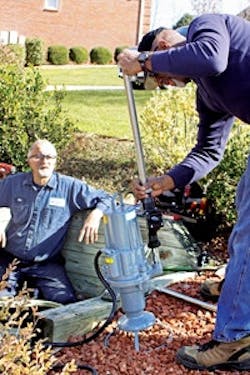Flygt Pumps in Lake Wylie, NC & SC
Robert Dohm knows a lot about fluid-handling pumps. He spent much of his working life as a pump mechanic at a chemical company’s plant in West Virginia. When he retired, he built his dream home within a new residential development along Lake Wylie, a 13,400-acre man-made lake in both North and South Carolina. He built on one of the initial waterfront homesites platted atop a virtually impermeable former gravel pit.
Project Background
“At the time we built the house there was no connection available to a community sewer system,” Dohm said. “Since the rocky ground would not percolate, the developer had bought a more porous site large enough to install a common septic tank with suitable soil and had an engineer design a low-pressure system to accept the raw sewage there from 15 homes.”
“It was a good design that would have worked,” Dohm believes, “but it was changed in favor of each homeowner installing an individual septic tank to accept the sewage before it passed through a grinder pump. The grinder pump was then pumping effluent. Unlike the raw sewage, the greywater built up hydrogen sulfide gas that attacked the pumps. They weren’t designed to withstand that kind of operating environment.”
“We went through several pumps in the following years…neighbors also experienced pump failures, probably 17 pumps in all.”
Solution
“My original pump lasted only four years and wasn’t worth fixing when they pulled it,” he recalls. “It was replaced at no cost by the supplier but it cost us $2,000 to replace a third pump a few years later. Even that pump had developed a loud bearing noise so I had to replace or repair it. At that time I decided to replace it with a Flygt pump.”
Dohm’s expertise with pumps once again came into play during the fourth pump replacement in 2012. The Flygt progressive cavity grinder pumps, introduced by Xylem, Inc., are especially suited for waterfront, remote and low-lying locations. The typical residential applications are individual homes, a small network of residences or an apartment building.
“I liked the pump’s design features…the electrical controls are not mounted inside the new pump but in a weatherproof box outside the sump and therefore clear from possible flooding in the sump.”
Result
By moving the controls out of the sump, the existing wet well/dry well configuration was converted to a complete wet well that increased the storage capacity by 40 percent. The work also changed the method of level control from a built-in pressure transducer to a level stick that allows for a lower maintenance alternative. These changes are particularly important in the event of an extended power outage.
Dohm is optimistic that the chronic pump failures are finally behind him. “There are about 30 remaining lots to develop here and two-thirds will probably need to pump their sewage to the collection line,” he said. “Some will probably want to see our system. The elimination of individual septic tanks and our connection to the municipal collection line should eliminate what we experienced and make the lots more marketable.”
Editor's Note: Scranton Gillette Communications and the SGC Water Group are not liable for the accuracy, efficacy and validity of the claims made in this piece. The views expressed in this content do not reflect the position of the editorial teams of Water & Wastes Digest, Water Quality Products and Storm Water Solutions.
